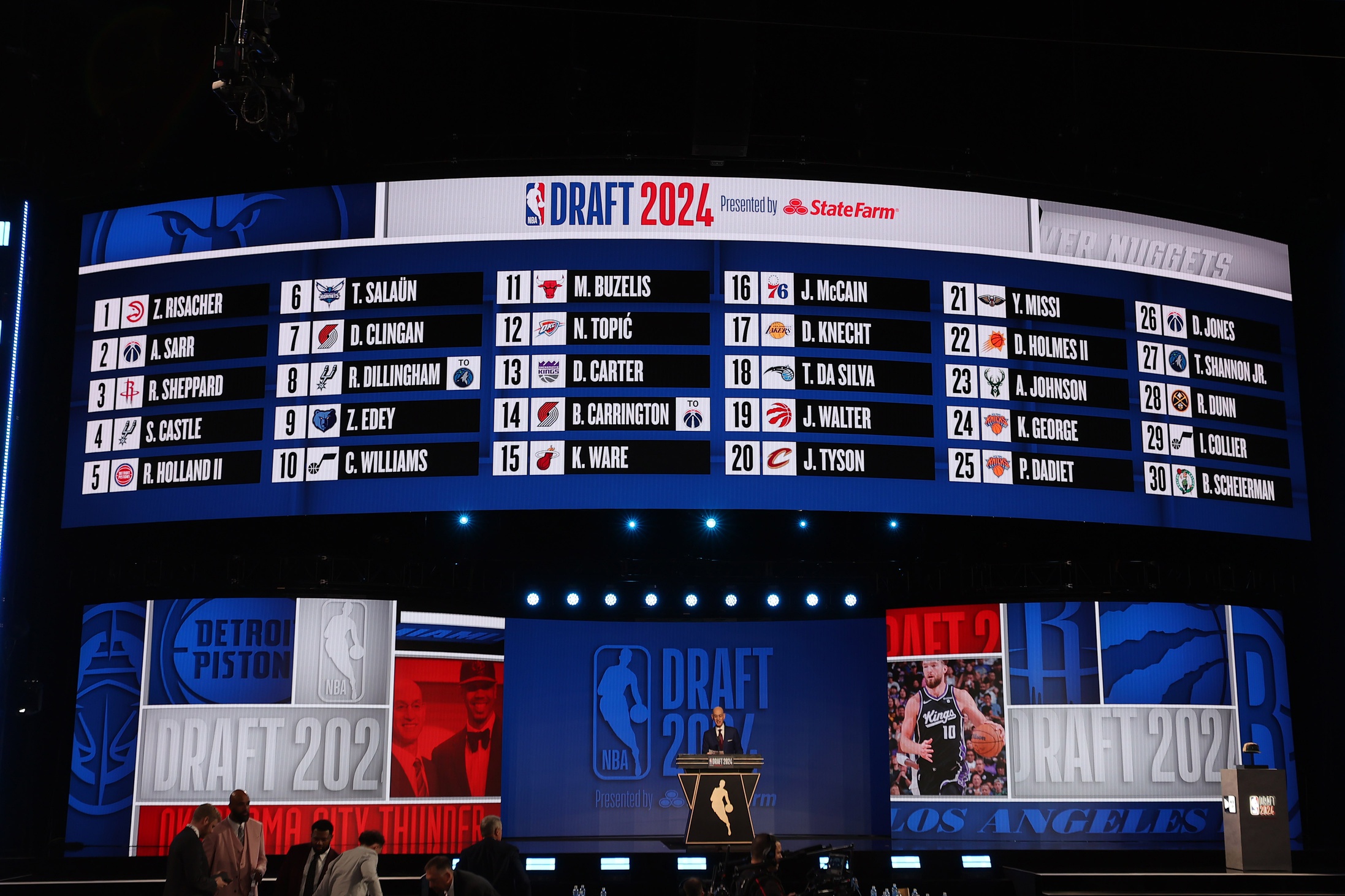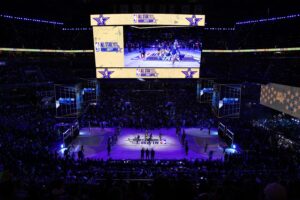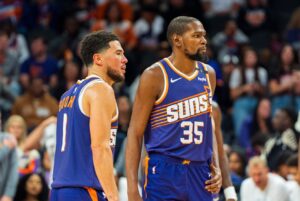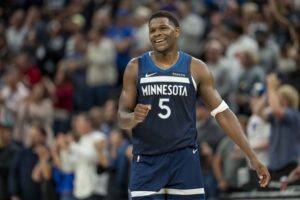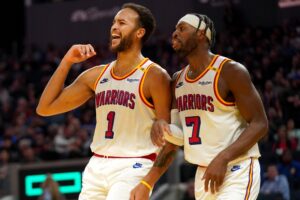The 2024 NBA draft is officially complete, and it’s time to analyze the perceived winners and losers of this draft. While the 2024 class was considered weaker due to lack of star power, it promises great depth unlike other classes. With that in mind, scouting departments had an even more important task in evaluating player value.
In every draft class, there are always both great successes and great failures alike. It’s important to remember, however, that prospects’ game on the court will always be the final determinate of draft success.
Let’s take a look at our 2024 NBA Draft winners and losers.
2024 NBA Draft Winners and Losers
Winners:
Utah Jazz:
The Utah Jazz might have got the best ‘bang for their buck’ in this draft class. Out of all the winners and losers in this NBA draft, the Jazz may have made out like bandits. The Jazz are currently in a soft rebuild and have some competitive pieces on the roster. I thought going into the night that a point guard prospect was needed to allow rookie standout Keyonte George to play more off-ball. Nikola Topic was thought to be the target at pick 10, but they made out even better considering Topic’s injury concerns. They grabbed Cody Williams at pick 10, and got point guard Isaiah Collier at pick 29. Both of these prospects were in contention at number one overall midway through their college seasons!
Williams is a six-foot-eight slender wing who played one season at Colorado. He’s also the younger brother of rising star Jalen Williams who’s with the Thunder. He’s a smooth and fluid athlete who looks to have a very polished all-around game for his age. He needs to develop an elite skill, but young wings with production and upside like Williams are always valuable.
Now for Collier, he really was the perfect combination of fit and best available at pick 29. Many thought he would go in the teens or the early twenties on draft night. Collier is a big and physical point guard listed at six-foot-five and 210 pounds. This physicality should fit with the Jazz well. He uses size as well as solid athleticism when finishing at the rim, and he can be a floor general on offense. The Jazz have the timeline in place for him and Williams to develop properly though. They will have a very intriguing young core to continue to build upon next season.
As if this wasn’t enough, the Jazz also got to stop the fall of Kyle Filipowski with the 32nd pick of the second round. Filipowski was easily a first-round talent according to many mock drafts. He will be a skilled power forward that can make an immediate impact for the Jazz.
Phoenix Suns:
The Suns only had one selection in this NBA draft, and it was the perfect selection. Suns fans should have a joyous reaction seeing Ryan Dunn at pick 28 in this NBA draft. The Suns have plenty of stars who can put the ball in the basket. They now need to surround those stars with elite role players, especially ones who can defend. There’s no better defender in this class than Dunn. He’s one of the more special defensive prospects we’ve seen in a long time. He may step in and be able to guard all five positions on the basketball court. Dunn’s a six-foot-eight forward with elite mobility and athleticism. His offensive game is virtually nonexistent in every area, but again, the Suns don’t need offense. If he develops just a perimeter shot offensively, he will be a major steal.
The Suns got their guy in Dunn even after trading down six spots with the Denver Nuggets. They also picked up Oso Ighodaro, a very versatile center prospect who can contribute from day one. He’s athletic enough to be a lob threat while also having the basketball IQ to act as an offensive hub. The Suns did a fantastic job surrounding their stars with elite role players in this draft.
Minnesota Timberwolves:
The Timberwolves made the first big trade of the night with the Spurs for Rob Dillingham, the eighth overall pick. Dillingham is a twitchy scorer who plays with a lot of flash giving him elite shot-creation ability. His main concerns are his size at six-foot-one and his defensive capabilities. I thought Dillingham was a perfect fit for the Spurs because he’d be surrounded by perimeter defenders and interior shot-blocking with Victor Wembanyama.
Well the Timberwolves have even better perimeter defenders and the three-time DPOY in Rudy Gobert protecting the paint. So Dillingham will still be surrounded by the number-one defense from last season and will have a more refined role for a contending team. The one thing the Timberwolves were missing was someone who could consistently create their own shot outside of Anthony Edwards. They also could use a backup point guard for Mike Conley, who’s now 36 years old. Dillingham kills two birds with one stone. He can play backup point guard and be a microwave scorer anytime they need him to be.
The Timberwolves also selected another bucket-getter in Terrance Shannon Jr at pick 27. How they didn’t have to give Shannon up in the Spurs trade is still a mystery. It definitely makes them one of the winners of this NBA draft though. Their 2030 and 2031 draft picks were lost, but this is a small price to pay for a legit championship contender.
Los Angeles Lakers:
Bronny James is what’s going to make headlines, but Dalton Knecht at pick 17 is fantastic value. Don’t get me wrong though, selecting James to play with his father is honestly a historic moment. No father and son have ever been in the NBA at the same time, much less playing on the same team. Like it or not, it’s a very surreal and unique moment for the James family.
Now for Knecht, JJ Redick’s tenure as head coach couldn’t have started out with a more perfect fit. The Lakers needed shooting, and Knecht is a star in that area. He also has plus size at six-foot-six and has shown great athleticism in games as well as the combine. Knecht fell due to his age, but the Lakers will use him to try and win now with Lebron James steadily aging. Knecht put up big-game performances seemingly every night as he took the college world by storm. He’s a six-foot-six wing who’s a great perimeter shooter and also goes for big dunks when given a runway. His movement shooting ability sprinkled in with highlight dunks is very similar to a later-career Terrence Ross.
Knecht has also shown value as a cutter making him a good off-ball role player. Role players will be valued in this draft, and his overall ability is very similar to Bogdan Bogdanovic of the Hawks. Currently, Knecht isn’t the best lateral mover on defense, but there’s reason to believe he will be serviceable. He should provide quality scoring and shooting on the wing for the Lakers.
Losers:
Detroit Pistons:
Now let’s be clear, Ron Holland is a fantastic prospect. Our mock had him sixth to the Hornets, which is only one selection after the Pistons’ fifth pick. The problem is, the Pistons’ current roster construction seems to be an awful fit for Holland. This take is a Pistons’ organizational problem far more than it is with Holland as a prospect.
The Pistons were looking for young wing talent, but preferably someone with a positive shooting reputation. Perimeter shooting and shot creation are actually Holland’s two biggest areas of concern. A lineup including Holland, Jalen Duren, and Ausar Thompson makes for terrible spacing in the modern NBA. Also, Thompson along with Cade Cunningham and Jaden Ivey are all seen to be primary ball handlers. Even though the Pistons are in rebuild mode, Holland may not have much opportunity to develop with the ball in his hands. He won’t get the volume shots or freedoms top five picks normally count on to reach their full potential. Oh and by the way, the Pistons still don’t have a coach. Is Holland himself one of the losers rather than the organization for this NBA draft?
On the bright side, the Pistons will be very young and extremely athletic with the addition of Holland. They will also have multiple plus defenders with positional versatility. Only time will tell if that’s enough to make up for poor fit and roster construction.
Milwaukee Bucks:
I have a hard time believing that AJ Johnson wouldn’t have been available at the Bucks’ pick at 33. The Bucks’ obviously have an aging roster and fancy themselves as contenders. If that’s the case, it makes sense to add young talent, but they should also have the ability to step in right away as a possible role player. Johnson is raw and is seen as a developmental prospect. He should need a few years before becoming a consistent NBA contributor. Nothing says this more than his minutes and points per game in the NBL this season. He averaged 2.9 points per game and played less than eight minutes each night. Granted, the NBL is a pro league, but the NBA is too and it’s the best in the world. Producing in the NBA very soon seems unlikely to say the least.
This choice is even more concerning considering Kyshawn George was the next pick at 24. George is a young six-foot-eight prospect who has the big upside and development potential the Bucks were looking for. However, he could have immediately played the spot-up shooting role, surrounding Giannis Antetokounmpo and Damian Lillard with floor spacing.
The only saving grace is their selection of Tyler Smith at pick 33. Smith should be a plus shooter at the forward position with good upside.
Atlanta Hawks:
With only a three percent chance, the Hawks were winners of the NBA draft lottery, receiving the number one pick. This was the only selection they would make, and it can be argued that this is the worst draft to have received the number one pick for. Don’t get me wrong, Zaccharie Risacher is a great prospect. Risacher has the tools and feel to be a successful NBA player for years to come. He’s a six-foot-nine French wing who fits what the NBA is looking for. He can shoot the three-ball and has great defensive versatility. Mikal Bridges could be a reasonable pro comparison if he continues to develop. Risacher will most likely never be a number one option though for an NBA team due to limited self-creation ability. Even still, Bridges isn’t a number one option and he just went for four first-round picks and then some.
The problem is, players in Risacher’s archetype fit best on contending teams, just as Bridges is now. The Hawks aren’t contenders, but they’re not exactly rebuilding either. Risacher reaching his potential may very well just keep the Hawks perfectly mediocre. Can you see how this isn’t the bright and wishful future that’s normally associated with number one selections?
Brooklyn Nets:
Out of all the NBA draft winners and losers, the Nets admittedly aren’t in as grim of a predicament. The Brooklyn Nets have 15 first-round picks through 2031 thanks to Bridges and Kevin Durant trades. They’ve also set themselves up well for the star-studded 2025 NBA draft class. However, this is winners and losers of the 2024 NBA draft, and they didn’t even get to make a selection. Thanks to the James Harden trade, the Nets saw their first round pick go to the Rockets at number three. The Rockets got a great player in Reed Sheppard who perfectly compliments their roster and timeline.
The Nets, however, did not get to add such help to their roster. This means they are likely to have an awful season next year while the Knicks are on the rise. That has to leave a bitter taste in a Brooklyn fan’s mouth. The future is bright, but the present is bleak at best.
To Be Determined:
Charlotte Hornets:
The ‘to be determined’ status is largely due to the selection of Tidjane Salaun with the sixth overall pick. Salaun is a tantalizing talent and if successful, he does fit Charlotte’s roster and timeline well. His fit as a jumbo-wing should go well alongside LaMelo Ball and Brandon Miller. He’s also the youngest player in class. Salaun is a lanky six-foot-ten wing who has shown a clean shooting strike combined with solid athleticism. At first glance, teams will be reminded a lot of Michael Porter’s athletic profile as a pro comparison. He’s still a project pick in most eyes, but he’s flashed enough to suggest he may be further along in his development than previously believed. Given his coveted archetype and high upside, the jury is still out on if the Hornets were winners or losers in this NBA draft.
Memphis Grizzlies:
Arguably the most controversial pick of the night, the Grizzlies selected Zach Edey with the ninth overall pick. This may feel high for many fans, but Edey’s draft range was all over the place due to his archetype. Edey’s archetype as a big with no perimeter game and limited mobility usually doesn’t bode well for an illustrious NBA career. He’s a seven-foot-four giant though whose sheer production got him selected ninth overall.
He averaged 25.2 points, 12.2 rebounds, and 2.0 blocks per game as a senior. This included a 37-point performance in the national championship game against UConn. If he can prove his shot blocking and length are enough to make up for a lack of mobility, the Grizzlies will get a great defensive anchor. Desmond Bane and Ja Morant should have a great screen-setter and interior presence on the offensive end. He will also be allowed to play alongside Jaren Jackson Jr, who can block shots but doesn’t mind being out on the perimeter. Only time will tell if Edey makes the Grizzlies an NBA draft winner or loser, but this is a great team fit.
Oklahoma City Thunder:
Although considered to be a team in title contention, the Thunder are still playing the long game. After trading Josh Giddey for a win now piece in Alex Caruso, did they draft Giddey 2.0? Topic is a Serbian six-foot-six point guard who can run the show and played internationally. Topic can be an advanced, passing point guard with plus size to get everyone involved. Does that profile sound familiar? Topic sustained multiple knee injuries and a partially torn ACL causing him to fall to the Thunder at pick 12. He was once in consideration at number one overall. The Thunder have already expressed he won’t be expected to play for next season. This allows Topic to return to full form and potentially give the Thunder a steal at pick 12.
The Thunder also traded up to select Dillon Jones at 26. Jones is a senior who spent four years at Weber State, and is a flat out baller. He doesn’t necessarily fit any normal NBA archetypes though. He’s a six-foot-five 230 pound guard/forward that does a little bit of everything. He averaged 20.8 points, 9.8 rebounds, 5.2 assists, and 2.0 steals per game in his senior season. He may not be the normal wing or guard prospect, but one thing is for sure. Jones can play the game of basketball very well. Only time will tell if he pans out into an NBA success.


